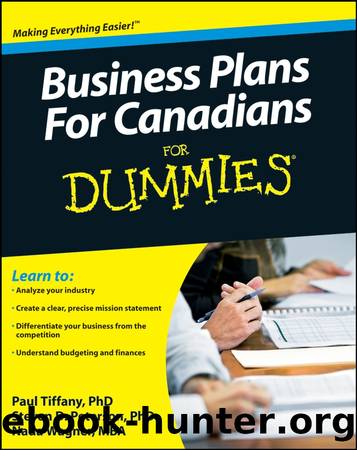Business Plans For Canadians For Dummies by Nada Wagner

Author:Nada Wagner
Language: eng
Format: epub
Publisher: Wiley
Published: 2010-05-27T00:00:00+00:00
Chapter 11
Figuring Out the Financial Details
In This Chapter
Understanding how you calculate profits
Balancing assets against your liabilities
Keeping track of your cash
Looking at your companyâs financial ratios
Numbers. Some people love them; others are bored by them; some begin to stammer, shake, and exhibit other physical signs of distress around them. But almost everyone agrees that â love âem or hate âem â numbers are the way that you keep track of things. Think baseball, cholesterol, the stock market, and (of course) your very own business venture. Numbers tell you more than simply the score at the end of the game or the final TSX closing, however. When you put them together in the right ways, numbers paint a detailed picture of everything from the career of a hockey player to the state of the global economy.
Youâre probably familiar with the financial forms that a bank requires when you want to borrow money for a new car, a bigger house, or your dream cottage at the lake. Those tedious documents include an income statement, as well as some sort of balance sheet. The income statement tells the bank where you get your money and where you spend it. The balance sheet lists the value of all the assets you own and balances the value against the money that you owe, including your car loans, mortgages, credit cards, and even personal I-owe-yous.
Financial statements tell the bank a great deal about you, and the bank discovers even more by taking numbers from the statements and calculating a bunch of ratios. The bank totals your monthly loan payments and divides that number by your monthly income, for example, and then compares this ratio with the average for other borrowers. The result gives the bank a good measure of your ability to repay the loan. Taken together, the statements and ratios create a financial portrait that the bank uses to get to know you better. And the better your bankers know you, the more comfortable they are with the decision to loan you money. The same goes for when you try to obtain money to start a business.
In this chapter, we introduce the basic financial statements and ratios that professionals widely use in business planning. In fact, these numbers look almost identical to those that paint a picture of your personal finances, only a little more complicated. We show you how an income statement and a balance sheet are put together. We explain cash-flow statements, which do pretty much what the name implies (they detail where the money comes from, where it goes, and how much is left over). Finally, we explore simple financial ratios that you can use to evaluate your business.
Reading Income Statements
An income statement presents the proverbial bottom line. By adding all the revenue that you receive from selling goods or services and then subtracting the total cost of operating your company, the income statement shows net profit â how much money your company makes or loses over a given period. Hereâs
Download
This site does not store any files on its server. We only index and link to content provided by other sites. Please contact the content providers to delete copyright contents if any and email us, we'll remove relevant links or contents immediately.
Bad Blood by John Carreyrou(6477)
Rich Dad Poor Dad by Robert T. Kiyosaki(6319)
Principles: Life and Work by Ray Dalio(6132)
Playing to Win_ How Strategy Really Works by A.G. Lafley & Roger L. Martin(5774)
Management Strategies for the Cloud Revolution: How Cloud Computing Is Transforming Business and Why You Can't Afford to Be Left Behind by Charles Babcock(4494)
The Confidence Code by Katty Kay(4158)
Thinking in Bets by Annie Duke(4121)
American Kingpin by Nick Bilton(3711)
Delivering Happiness by Tony Hsieh(3332)
Project Animal Farm: An Accidental Journey into the Secret World of Farming and the Truth About Our Food by Sonia Faruqi(3139)
The Power of Habit by Charles Duhigg(3022)
The Tyranny of Metrics by Jerry Z. Muller(2955)
Mastering Bitcoin: Programming the Open Blockchain by Andreas M. Antonopoulos(2951)
Brotopia by Emily Chang(2947)
The Marketing Plan Handbook: Develop Big-Picture Marketing Plans for Pennies on the Dollar by Robert W. Bly(2902)
I Live in the Future & Here's How It Works by Nick Bilton(2900)
The Content Trap by Bharat Anand(2837)
Applied Empathy by Michael Ventura(2811)
Building a StoryBrand by Donald Miller(2807)
